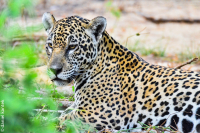 NOTICIAS
NOTICIAS
Jaguar genome helps unravel the complex evolution of the big cats
An international consortium led by Brazilian university PUCRS and including scientists from seven countries (Brazil, USA, Russia, Ireland, Portugal, Spain and Argentina) reported on July 19th in the journal Science Advances the complete sequence of the jaguar genome, along with in-depth analyses comparing it to all other living big cats (lion, tiger, leopard and snow leopard).
The study resolved the evolutionary relationships among these species and the timing of their diversification (starting about 4.6 million years ago), and revealed that their genealogical tree varies considerably across different parts of their genomes. This result allowed the scientists to identify evidence of historical hybridization between different species of big cats. This process may have contributed to their long-term survival, since the genome data indicated that all of these species have undergone population declines in the last 300 thousand years, leading to loss of genetic diversity over time.
Toni Gabaldón, ICREA research professor and group leader of the Comparative Genomics laboratory at the Centre for Genomic Regulation in Barcelona (Spain), in collaboration with CONICET researcher Patricia Saragüeta at the Institute of Experimental Biology (IBYME) in Buenos Aires (Argentina), participated in the comparative analysis of different species of big cats. They reconstructed phylogenetic trees for these species unraveling the history of the jaguar genes. Gabaldón was already involved in the Iberian lynx genome project, in which he also provided comparative analysis between genomes of other big cats.
Genome-wide analyses reveal interspecies admixture and adaptive evolution
One of the cases of hybridization detected in the study involved the jaguar and lion, and may have facilitated adaptation in one or both species. In the case of the jaguar, at least two genes (both involved in optic nerve development) that bear evidence of ancient admixture also contain signatures of positive selection, indicating adaptation.
Several other genes with signatures of positive selection were also identified in the big cats, affecting features such as vision, olfaction, reproduction, metabolism and development. Two of these genes, with signatures of selection in the jaguar only, are involved in skull development and may underlie that species’ particularly robust head and powerful bite, capable of piercing through the armor of reptiles such as caiman and large turtles.
The results open up new prospects for detailed evolutionary studies of the big cats, and are already being used to conduct population genomic analyses that will allow in-depth assessments of their diversity and historical adaptations to be incorporated into conservation planning on behalf of these endangered species.
Reference: Figueiró HV et al. "Genome-wide signatures of complex introgression and adaptive evolution in the big cats" Science Advances. 19 July 2017. DOI: 10.1126/sciadv.1700299
Media contact:
Laia Cendrós, Media Relations, Centre for Genomic Regulation (CRG) - Tel. +34 93 316 0237

